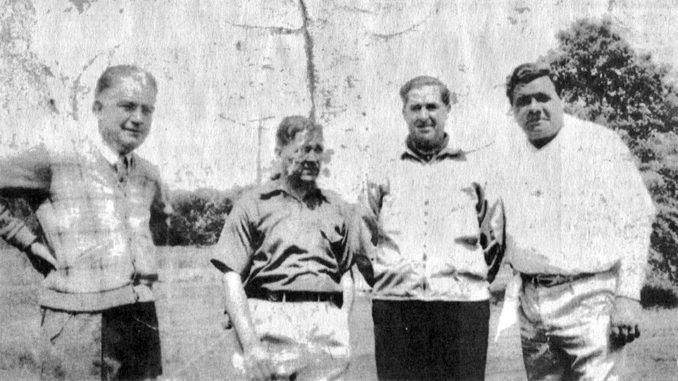
HAWORTH, N.J.—In 1938, baseball legend Babe Ruth spent a morning on the links at White Beeches Golf Club in Haworth—and lost like a champ, according to one of his golf partners.
Our foursome is pictured above in a May 13, 1938 photo at White Beeches. From left, composer and musician Zez Confrey, businessman Fred Cosgrove, club golf pro Chet Irwin, and the Great Bambino himself.
It was The Babe’s first time visiting the Haworth club, and after a 10 a.m. tee-off he went on to shoot an impressive 76 on the par-72, 18-hole course. Irwin topped him with a 73.
In 1996, a 91-year-old Irwin’s hometown newspaper, the Providence Journal-Bulletin out of Rhode Island, interviewed him about the long-ago day on the green.
Irwin had been playing golf since age 6, and turned professional as an adult. He played with the Connecticut section of the Professional Golfers Association (now the PGA), and in a career highlight his tee shot once flew the 356-yard 18th hole at Norwich Country Club—with a hickory-shaft wood club.
Irwin’s partner in the 1938 golf meetup was composer and pianist Edward Elzear “Zez” Confrey. Well-known in his day, Confrey’s biggest hits were “Kitten on the Keys” (1921) and “Dizzy Fingers” (1923).
Partnered with Ruth was businessman Fred Cosgrove, who was an average golfer but a savvy businessman. Cosgrove was the executive vice president of the posh Knott Hotels, and had plenty of celebrity connections— including Babe Ruth.
While Ruth was first introduced to golf at 20 years old and had done plenty of playing over the years, his interest in the game reached a fanatic level after his retirement from baseball in 1935. He even toyed with the idea of turning professional.
Ruth told a reporter in the late 1930s, “I played 365 rounds last year. Thank God for whoever invented golf.”
On the bright and mild morning of May 13, 1938, Ruth arrived at White Beeches acting cocky—he even bet Irwin $5 that he could best him on his own course. Trying to be gentlemanly, Irwin offered Ruth strokes.
“I offered because it was my course,” he told the Journal-Bulletin in 1996, adding with a chuckle, “and he called me all kinds of things.”
He added, “I was a kid to him. Everything was ‘kid.’ He’d say, ‘I’ll knock your a** off on the next hole, Kid. It was great fun, though.”
By the end of the ninth hole, Ruth was ahead by two with a score of 37 to Irwin’s 39.
“I get a scotch and soda in me, and I’ll beat your a** on the back nine, too,” Irwin recalled Ruth saying.
But at that farthest point from the clubhouse, Irwin broke the news to Ruth that he couldn’t get a drink after the ninth hole. Ruth, upset, accused Irwin of doing this on purpose.
“No, I didn’t,” Irwin told him. “If I had known you wanted a drink, I would have had one brought out to us.”
Irwin shot a 33 on the back nine to win.
Back at the clubhouse, Ruth, with great sportsmanship, handed over the $5 and made no sign that he was upset at losing. By that time, word had gotten around that The Babe was in Haworth. A huge crowd of waiting kids got their jackets, sweaters and hats autographed.
After lunch in the clubhouse—where everyone ate except for Ruth, who had only a scotch and soda—the men returned to the course for a nine-hole game. Ruth made par on every hole and won his $5 back.
Ruth returned to White Beeches once more later that summer.
“We went out and played, and I beat him badly that day,” Irwin told the Post-Bulletin. “Then I never did see him again.”
